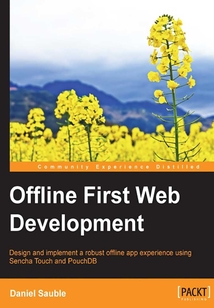首頁(yè) > 計(jì)算機(jī)網(wǎng)絡(luò) >
編程語(yǔ)言與程序設(shè)計(jì)
> Offline First Web Development最新章節(jié)目錄
舉報(bào) 

會(huì)員
Offline First Web Development
最新章節(jié):
Index
Doyouwanttomakeyourappexperiencemorerobustanddelightful?Areyoueagertowriteappsthatcatertoawideraudience,notjusttheSiliconValleycrowd?Doyouneedtopersuadeyourpeersthatoffline-firstisaworthwhiledevelopmentparadigm?Ifyouranswertoalloranyoneofthesequestionsisyes,thenthisisthebookisforyou.Somepreviouscodingandcommand-lineexperiencewouldbeuseful,butisnotrequired.
目錄(90章)
倒序
- 封面
- 版權(quán)頁(yè)
- Credits
- About the Author
- About the Reviewers
- www.PacktPub.com
- Support files eBooks discount offers and more
- Preface
- What this book covers
- What you need for this book
- Who this book is for
- Conventions
- Reader feedback
- Customer support
- Chapter 1. The Pain of Being Offline
- The offline paradigm
- Developing for a worst-case scenario
- Principles of a good offline design
- Making the case to yourself
- Making the case to others
- Summary
- Chapter 2. Building a To-do App
- Configuring the development tools
- Configuring Sencha Touch
- Creating a Git repository
- Designing the offline experience
- Creating a skeleton application
- Building an offline to-do app
- Comparing and contrasting with the design principles
- Summary
- Chapter 3. Designing Online Behavior
- Designing the online workflow
- The online/offline transition
- Adding an online data store
- Implementing image support
- Implementing mapping support
- Comparing and contrasting with the design principles
- Summary
- Chapter 4. Getting Online
- Offline databases
- Connecting to our Web API
- Adding online-only features
- Comparing and contrasting with the design principles
- Summary
- Chapter 5. Be Honest about What's Happening
- Exposing the system state to the user
- Building trust through up front communication
- Predicting the future
- Letting users provide direction
- Staying functional in bad network conditions
- Comparing and contrasting with the design principles
- Summary
- Chapter 6. Be Eventually Consistent
- What is a split-brain?
- Refactoring the item store
- Implementing conflict detection
- Implementing the conflict resolution
- Comparing and contrasting with the design principles
- Summary
- Chapter 7. Choosing Intelligent Defaults
- Low-hanging fruit
- Cache limits
- List frequency
- Clearing the cache
- Usage scenarios
- Comparing and contrasting with the design principles
- Summary
- Chapter 8. Networking While Offline
- What it means to be offline
- Device support
- Platform-independent libraries
- Synchronization over Wi-Fi
- Making the setup less painful
- Summary
- Chapter 9. Testing and Measuring the UX
- Manual testing
- Testing frameworks
- Before and after
- Future improvements
- Summary
- Appendix A. References
- Chapter 1
- Chapter 2
- Chapter 3
- Chapter 4
- Chapter 6
- Chapter 7
- Chapter 8
- Chapter 9
- Index 更新時(shí)間:2021-07-30 10:31:06
推薦閱讀
- ASP.NET Core:Cloud-ready,Enterprise Web Application Development
- Modular Programming with Python
- Java Web開(kāi)發(fā)之道
- 你必須知道的204個(gè)Visual C++開(kāi)發(fā)問(wèn)題
- 嚴(yán)密系統(tǒng)設(shè)計(jì):方法、趨勢(shì)與挑戰(zhàn)
- Jupyter數(shù)據(jù)科學(xué)實(shí)戰(zhàn)
- C語(yǔ)言程序設(shè)計(jì)教程
- INSTANT Adobe Edge Inspect Starter
- Learning YARN
- ArcGIS for Desktop Cookbook
- Django 3.0應(yīng)用開(kāi)發(fā)詳解
- Python程序員面試算法寶典
- Illustrator CS6中文版應(yīng)用教程(第二版)
- 威脅建模:設(shè)計(jì)和交付更安全的軟件
- Python 3.8編程快速入門
- 瘋狂Ajax講義(第3版)
- 網(wǎng)頁(yè)設(shè)計(jì)理論與實(shí)踐
- 開(kāi)源心法
- 看漫畫學(xué)Python:有趣、有料、好玩、好用(全彩版)
- Citrix XenDesktop? Cookbook(Third Edition)
- Learning OpenCV 4 Computer Vision with Python 3
- Mastering .NET Machine Learning
- 零基礎(chǔ)Python學(xué)習(xí)筆記
- TypeScript Design Patterns
- Matplotlib 2.x By Example
- Appcelerator Titanium Business Application Development Cookbook
- 數(shù)字媒體交互設(shè)計(jì)(中級(jí)):App產(chǎn)品交互設(shè)計(jì)方法與案例
- Kotlin Blueprints
- 32位匯編語(yǔ)言程序設(shè)計(jì)(第3版)
- Reporting in TFS

